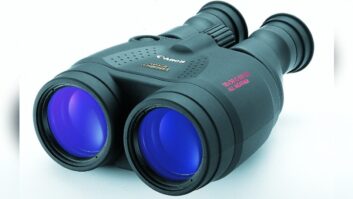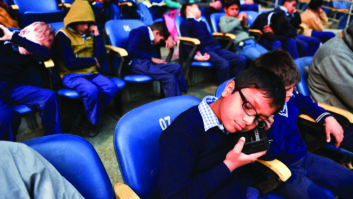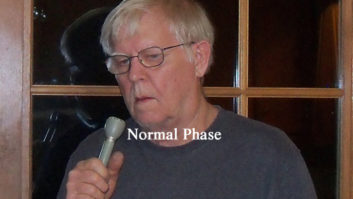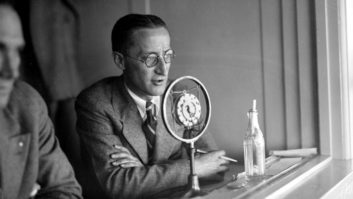It’s Not the Flux Capacitor, MartiQuestion posed in the Feb. 16 issue
(Exam level: CBRE)
Your remote crew tells you that there is something wrong with their 10 watt 160 MHz RPU transmitter. On site you realize that you need to substitute a dummy load to ascertain if the problem is the transmitter or antenna. Your dummy is back on the bench, but in your kit you have the resistors listed below. How can you quickly arrange them to make a workable 50 ohm load?
Quan Value (ohms) Power handling (watts) 4 100k 1/2 2 620 1/2 2 150 1/2 4 100 1 1 100 5
a. There is no solution as the 1/2 watts will blow no matter what at 10 watts input.
b. Put all the above resistors in parallel.
c. Put the four 100 ohm 1 watts in parallel and then series these with the 100 ohm 5 watt.
d. Make a series parallel network out of the four 100 ohm 1 watts (two series 100 ohms with these series pairs in parallel) and this network paralleled with the 100 ohm 5 watt.
e. Parallel all the 100 ohm resistors.
SBE certification is the emblem of professionalism in broadcast engineering. To help you get in the exam-taking frame of mind Radio World Engineering Extra poses a typical question in each Certification Corner. Although similar in style and content to exam questions, these are not from past exams nor will they be on future exams in this exact form.
The correct answer is d.
When you step back and think about our work in broadcasting, a large portion of our technical effort is conservation of power. At the transmitter, since that plant runs near continuously, we want to get as much radiated as possible for the smallest supporting costs. Every watt that does not come out of the antenna is essentially turned into heat.
(click thumbnail)
Schematic of arrangement based on our limited choices that comes closest to 50 ohms In the case of a transmitter dummy load, we need to turn all that RF power into heat.
An ideal dummy for a transmitter requires some specific qualities. First and foremost, it needs to mimic the antenna load that the transmitter normally sees. Since this is most often a 50 ohm resistive load, the ordinary station dummy load is 50 ohms.
Second, it has to have sufficient power handling capability such that it does not enter self-destruction mode as soon as you apply power.
This last item about power handling is important. Do I dare repeat a story that has brought me much chagrin already?
While testing modulation at a full 1 kW power on a beautiful MW-1 — which I had completely refurbished in my garage for the distinguished Reverend Marvin Oliva, whose active radio ministry, La Cosecha del Tiempo Final, spans most of Central America — I fried my 500 watt dummy load listening to Kiri Te Kanawa sing the “One Fine Day” aria from Madame Butterfly. Guess I was just carried away by those crystal-clear high notes and didn’t put together that the burning smell was overheated oil in the dummy.
(click thumbnail)
Air-cooled dummy loads like this 20 kW unit grace medium-powered radio stations throughout the world; no water for cooling is required. In the case of this specific question, we have two luxuries. First, we need only a short test; second, we don’t have a requirement to be exactly right; we only need to be close enough for a test that allows us to eliminate the Marti as the source of the problem.
The section of our dummy load comprised of the four 100 ohm, 1 watt resistors has a combined resistance of 100 ohms. Kirchhoff’s Laws tell us then that the current flowing through this 100 ohm path will be identical to that flowing through the single 100 ohm 5 watt resistor. (In 1845, German physicist Gustav Kirchhoff described two laws that became central to electrical engineering. The laws were generalized from the work of Georg Ohm. They can also be derived from Maxwell’s equations but were developed prior to Maxwell’s work.)
From Ohm’s Law, the dissipated Power = Current² x Resistance, so if we need to dissipate a nominal 10 watts in 50 ohms then the current flow will be approximately 0.45 amps. Half will flow through each 100 ohm path or 0.225 amps. The power dissipated in the 100 ohm 5 watt resistor will be nearly 5 watts. Similarly, the current flow through each 200 ohm leg (two 100 ohms in series) will be half the total current in this branch, or 0.1125 amps. This works out to 1.25 watts in each of those 100 ohm 1 watt resistors (using Ohm’s Law above again).



A smaller air-cooled dummy load shown with mechanical patch bay. Power ratings for resistors are generally the handling limit for continuous duty in standard pressure and ambient conditions of still air.
Obviously we couldn’t let this remote pickup transmitter operate for long, asking these little resistors to handle an additional 25 percent of power; but for the few moments that are needed for our quick test, they’re up to the stress.
The Famous Cantenna
We talked about the need for a dummy load to mimic the antenna in both resistance and reactance. A well-designed antenna matching system will actually present a completely resistive load to the transmitter. To reduce the reactance in the dummy load, big power-handling resistors are usually carbon composite for minimal cumulative reactance. If wire types are necessary, an input correction network is needed to zero the reactance. No matter what, each resistor is carefully selected and tested to make certain that they maintain their rated resistance at operating temperatures.

Leo the cat turns his attention to Buc’s classic CanTenna. As mentioned, all of the power is turned into heat and will build up quickly if not transported elsewhere, so just about every dummy over 1 kW has some system of fans or oil flow or heat sink transfer scheme to get rid of the heat before self-destruction.
Every ham has seen or owns one of those classic CanTennas from Heathkit. Rated for a kilowatt of ham radio power, this unit was a 50 ohm carbon composite resistor immersed in a gallon of cod liver oil or distilled water in a paint can. The design allowed about 10 minutes of 1 kW of transmitter on and 20 off. The CanTenna was adequate for 1 kW key down CW for a few minutes and similar low duty cycle SSB testing.
The CanTenna can be used to test a 1 kW AM broadcast rig with modulation. To handle the extra sideband power, one needs to place the can on a brick in a bucket such that the top of the can is just above the bucket top. A garden hose is then used to let that cool water (tap water is usually about 54 degrees F) flow into the bottom and over the bucket top. This water overflow facilitates a heat exchange where the heat coming off the can is given up to the cooler, flowing water. If one limits transmission to 5 minutes on and 10 off, you can tune and troubleshoot your rig off the antenna with modulation.
Missed some past articles or want to review them in preparation for your next exam? Find Certification Corner articles under the Columns tab at radioworld.com.
Charles S. “Buc” Fitch, W2IPI, is a registered professional consultant engineer, member of the AFCCE, senior member of the SBE, lifetime CPBE with AMD, licensed electrical contractor, former station owner and former director of engineering of WTIC(TV) in Hartford, Conn., and WHSH(TV) in Marlborough, Mass.
Class DistinctionQuestion for next time
(Exam level: CBRE)
All stations in the commercial part of the FM band are protected to their 1 mV/m contour except for:
a. Class A and full Class C
b. Class B and Class D
c. Class B and Class C2
d. Class B and Class B1
e. Class B1 and C1












